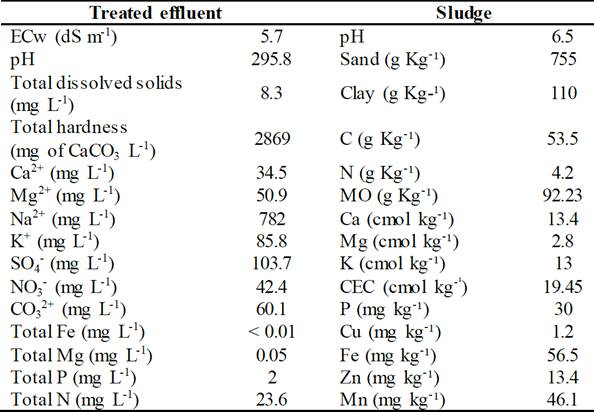1. Introduction
Maize cultivation in the Brazilian semi-arid region stands out for its economic importance in family farming, with a high contrast in yield due mainly to climatic conditions, irrigation and fertilization practices [1,2]. Due to water scarcity in the region, the use of wastewater for irrigation is a promising alternative for reducing the consumption of higher-quality water and hence reducing environmental contamination [1].
[2], investigating the influence of different doses of wastewater, associated with mineral fertilization, on plant growth and production in maize cultivation, found that the application of wastewater did not reduce plant yield. [3] evaluated the development of lemon grass (Cymbopogon winterianus) irrigated with treated domestic sewage, from an Upflow Anaerobic Sludge Blanket (UASB) treatment plant, and verified a higher potential for the use of nutrients when compared to that irrigated with domestic supply water. [4] investigated the growth of sunflower plants irrigated with tap water and treated domestic sewage effluent associated with organic fertilization, in the Brazilian semi-arid region. The authors verified that the use of domestic sewage effluent for irrigation generated a promising result for sunflower growth compared to the use of domestic supply water, with significant increases in biometric variables.
[5] evaluated the effect of different proportions of organic compost containing sewage sludge on the substrate composition for the initial development of maize plants in a greenhouse and found that the sludge application on the substrate promoted a greater maize production, resulting in a larger stem diameter, plant height, number of leaves and increased dry matter. Examining the use of sewage sludge as a fertilizer in maize crops in an Oxisol, [6] found that the sewage sludge had positive influence on the maize crop development, constituting a feasible alternative for the use of mineral fertilizers from both an economic and an environmental point of view. [7] verified the high potential of domestic effluent and sludge from the UASB reactor in the development of sunflower, maize and sorghum.
Despite the supply of nutrients, the water reuse and sewage sludge might impact the agronomic soil quality [8] and the agricultural sustainability, depending on its physical-chemical characteristics. Thus, proper management in agricultural production requires knowledge about the uniformity of crop yield and soil attributes, and their spatial variability, thus enabling the adoption of specific management zones [9]. Geostatistical analysis has been an adequate technique for the analysis of spatial dependencies [10], allowing the identification of variables that show spatial correlation under different management conditions [11].
In this context, the present study aimed to evaluate the spatial variability of soil salinity and the development of a maize plantation irrigated with reused water from treated domestic wastewater, associated with sewage sludge, as well as investigating the spatial dependence of soil and crop attributes in the Brazilian northeastern semi-arid region.
2. Material and methods
2.1 Location and description of the experimental area
The experiment was carried out from May to September 2016, at the Pilot Experimental Unit of Sewage Treatment and Hydro-Agricultural Reuse, situated in the municipality of Pesqueira (Pernambuco, Brazil) (Fig. 1). The soil of the study area is a Planossolo Háplico Sálico Sódico Hipereutrófico (Albaquult), with sandy loam texture and a soil density of 1.42 kg dm-3, mean field capacity and permanent wilting point of 0.14 g g-1 and 0.02 g g-1, respectively [12].
The Demonstrative Unit was built by the Pesqueira Municipality, in partnership with the State Water Resources Secretariat, and the Federal Rural University of Pernambuco State (UFRPE) is responsible for conducting hydro-agricultural reuse of treated sewage, thus contributing to productive coexistence with water scarcity and environmental management in the semi-arid region.
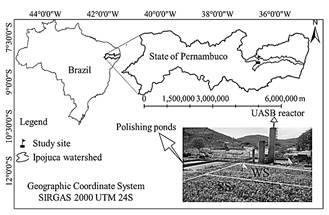
Source: The authors.
Figure 1 Location of the sewage treatment unit in the Ipojuca River Basin, in the municipality of Pesqueira, Pernambuco, Brazil
The regional climate is classified as BSHW (hot semi-arid) according to Köppen’s classification, with mean annual rainfall of 670 mm. Rainfall and climate variables for reference evapotranspiration (ETo) estimation using Penman-Monteith Method (FAO56) were daily measured in an automatic weather station installed at the demonstrative unit. During the experiment, the total precipitation was 117.2 mm, the average temperature was 23.2 ºC, ranging from 15.4 to 35.9 ºC and the reference evapotranspiration was 416 mm. The drip irrigation method used was a localized low-cost drip, “Xique-Xique” type. The applied irrigation depth was based on the crop water requirement, with a two-day irrigation interval.
Wastewater treatment is through a UASB reactor (Upflow Anaerobic Sludge Blanket), with polishing ponds installed after the reactor. The station serves part of the Mutuca District, corresponding to 150 residences, with an average of 5 residents per unit, producing an average flow of raw sewage of 3 m³ day-1. Two experimental plots with 40 (10 x 4) monitoring points, spaced 1 m apart, were cultivated with maize (Cultivar São José IPA - BR 5026). The rows were spaced 1 m and the plants 1 m apart, adopting the following treatments: maize cultivation irrigated with wastewater without sludge (WS) and maize irrigated with wastewater, plus an application of stabilized sewage sludge (SS). The characteristics of the treated effluent are described in Table 1.
CONAMA Resolution 375/06 of the Brazilian Environment National Council [13] defines some criteria in relation to the agricultural use of sewage sludge generated in sanitary sewage treatment plants, establishing limits for zinc, copper and manganese concentrations of 2800, 1500 and 50 mg kg-1, respectively. The Resolution also requires the monitoring of organic substances in the sludge, without specifying maximum concentration limits.
2.2 Analyzed variables
At 118 days after sowing (DAS), plant biometrics were evaluated for: crop height (CH), crop stalk diameter (CSD), and number of leaves (NL), following the methodology of [14]. Regarding soil parameters, soil moisture (SM) was evaluated from soil samples collected near each plant by the gravimetric method, in the 0-0.20 m layer, and electrical conductivity (EC) was obtained by the soil solution reading. Soil texture was evaluated following the methodology of [15]. The biological parameter was mapped based on the investigation of the spatial dynamics of organic matter (OM) evaluated according to the method of [16]. The chemical aspect of the soil was evaluated by the levels of sodium (Na) and potassium (K), determined by the method of flame photometry. Soil sampling was carried out just before irrigation.
2.3 Statistical analysis
Classic statistical analysis was carried out and normality was evaluated by the Kolmogorov-Smirnov test at 0.05 probability level. Data were also subjected to analysis of variance, applying the null hypothesis of F test. The coefficient of variation (CV) was classified according to [17] as of low variability (CV < 12%), intermediate variability (12 ≤ CV ≤ 60%), and high variability (CV > 60%).
2.4. Geostatistical analysis
For the geostatistical analysis, the GEOEAS software was used. Semivariance theoretical fits were tested for the Gaussian, Spherical, and Exponential models, adopting the model which provided the best fit, based on the determination coefficient. Outliers were detected and removed based on the criteria of [18]. The fitted models were validated using the Jack-Knifing technique [19], in which each of the measured values is interpolated by the kriging method, and the measured values are then replaced with those estimated and then the distribution of standardized errors is calculated, which must have an average close to zero and unit standard deviation [20]. After semivariogram validation, data kriging was performed and isoline maps were produced.
The Spatial Dependence Index (SDI) was calculated according to [21] as the ratio between the nugget effect and the sill of the theoretical semivariograms, which represent the nugget semivariance as the percentage of total semivariance. This criterion establishes strong dependence when a given ratio is lower than 25%, moderate for a ratio between 25 and 75%, and weak when the ratio is higher than 75%.
For the variables that did not show spatial dependence, the mapping was performed using the Inverse Distance Weighting (IDW) method, which estimates the variable over space, weighing weights for each of the nearest n points [22], that is, the closer to the point to be estimated, the greater the weight attributed to the sampled point. In the present study, a function of the inverse of a power 2 of the distance was adopted, that is, the Inverse Distance Square (IDS) was used.
3. Results and discussion
The classical statistical analysis for both treatments with wastewater without sludge (WS) and wastewater plus anapplication of stabilized sewage sludge (SS) can be verified by inspection of the box plots, shown in Fig. 2. Statistical behavior of soil moisture (SM), electrical conduction (EC), organic matter available in soil (OM), sodium (Na) and potassium (K) contents, sand (SC) and clay (CC) contents, crop height (CH), crop stalk diameter (CSD) and the number of leaves (NL) is presented.
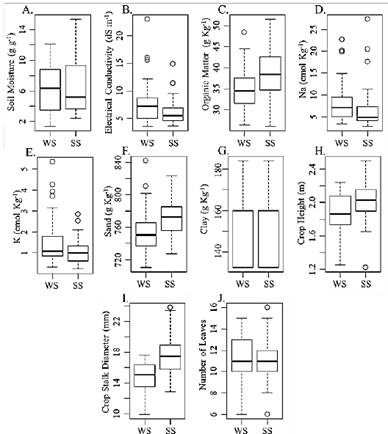
Source: The authors.
Figure 2 Box plots for the % soil moisture (g g-1) (SM), electrical conductivity (EC), organic matter available in soil (OM), sodium (Na) and potassium (K) contents, sand (SC) and clay (CC) contents, crop height (CH), crop stalk diameter (CSD) and the number of leaves (NL).
The soil moisture in SS treatment shows negative asymmetry and higher data amplitude compared to the soil moisture of the WS plot.
Electrical conductivity (EC) and sodium content had similar results, with the highest values being observed in the WS treatment. It was also observed that, as the increase in the soil electrical conductivity, a greater availability of Na was also found, corroborating a study conducted by [8], when assessing the attributes and quality of soil irrigated with domestic treated sewage in sugarcane cultivation.
Regarding organic matter (OM), it is observed that the first and third quartiles exhibit adequate symmetry around the median value, which is consistent with the hypothesis of normal distribution. The average OM of the SS plot (38.64 g kg-1) was 10% higher than that of the WS plot (35.11 g kg-1). Such results are in accordance with those obtained by [23], who found that the application of sewage sludge allowed an increase in the levels of soil organic matter, thus increasing its potential for the development of agricultural crops.
All variables, except for K content in SS treatment, showed normal behavior at 0.05 probability level according to the Kolmogorov-Smirnov test. The non-normal variable was normalized by the logarithmic transformation. Table 2 presents the classical statistics for the soil attributes and crop development variables for the experimental plots at 118 DAS for both treatments.
Table 2 Classical statistics for both treatments with wastewater without sludge (WS) and wastewater plus an application of stabilized sewage sludge (SS) at 118 days after sowing.
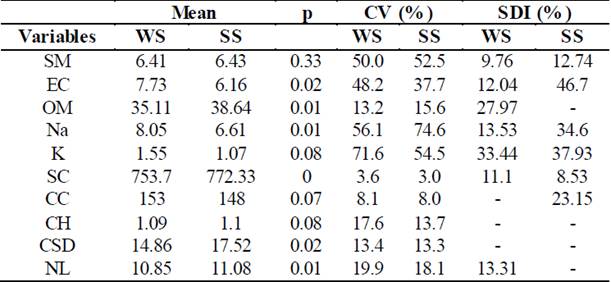
CV - Coefficient of variation; SDI - Spatial dependence index; SM - % soil moisture (g g-1); EC - electrical conductivity (dS m-¹); OM - organic matter (g kg-¹); Na - sodium content (cmol kg-¹); K- potassium content (cmol Kg-¹); SC- sand content (g kg-¹); CC- clay content (g kg-¹); CH - crop height (m); CSD - crop stalk diameter (mm); NL - number of leaves (unit); Significance level of p < 0.05 by the F test.
Source: The authors.
The mean values for the crop development variables CSD, NL and CH with wastewater without sludge (WS) (14.86, 10.85, 1.09) and wastewater plus an application of stabilized sewage sludge (SS) (17.52, 11.08, 1.1) were lower than those found by [24], using the same cultivar under rainfed conditions, which was grown in the same period in a Argissolo Vermelho Amarelo (Ultisol) under bare soil condition (14.64, 10.52, 1.44) and with mulch cover (18.08, 11.82, 1.75).
There was no significant difference in soil moisture (SM) for both treatments (WS and SS). Similar results were found by [24], who also found no significant difference in treatment with application of sludge compared to no application; however, they observed the stabilization of the mean soil moisture over time when sewage sludge was applied to the soil.
The OM showed a significant increase in SS treatment. Similar results of increased organic matter content were also found by [25], when they evaluated the effects of applying a biosolid to the soil under Brachiaria sp. According to [26], organic matter produces positive effects on the supply of nutrients to plants, on the structure, and on the water holding capacity, linked to the soil quality and fertility.
The Na content in SS treatment showed a significantly lower average when compared to that in the WS treatment. Such result is promising, considering that high sodium contents might compromise the soil agronomic quality, being a critical variable [8].
The crop stalk diameter in SS treatment showed a significantly higher average, according to the F test at 5% probability level, compared to that of the WS treatment. For [27], such increase is an important result not only for the maize support structure, but also for the storage of sugar and nutrients, which will be used for the growth and filling of grains. The nutrients available in the sludge are present at high concentrations, satisfying the nutritional needs of the plant, as highlighted in Table 1.
Crop heigh (CH), crop stalk diameter (CSD) and number of leaves (NL) showed lower coefficients of variation in the SS treatment, but all were classified as of intermediate variability. [11] found low variability for plant height and number of leaves under bare soil conditions compared to natural mulch cover treatment, under rainfed conditions in the same growing period, in the Pernambuco State semi-arid region. K contents were classified as of high variability in the SS treatment and the Na content was classified as of high variability in the WS treatment. The others had low CV.
High correlation according to the Spearman coefficient was found for soil moisture (SM) and the crop stalk diameter (CSD) in SS treatment, with a coefficient of 69%. A high correlation was also found between SM and EC for the WS and SS treatments, and among the EC, Na and K contents, with coefficients greater than 72%. There was also a high correlation between textural variables and soil OM content, where the CC and OM showed a correlation coefficient of -51%, which establishes that the lower the clay content in the area, the greater the content of organic matter. It is worth mentioning that the plot area has been irrigated for about ten years.
The agricultural use of sewage sludge is related to the addition of sand, nutrients, and organic matter to the soil. The effect on plants is like that of an organic fertilizer, which according to [28] promotes a decrease in the spatial dependence of maize production. However, the soil variables showed between strong and moderate dependence, according to the SDI, meaning that such measures were not randomly distributed in the experimental plots. Regarding the plant biometrics parameters, spatial dependence was found only for the number of leaves (NL) in the WS treatment.
Experimental and theoretical semivariograms are presented in Fig. 3 for soil attributes and maize biometric variables, for both WS and SS conditions. Number of pairs for each experimental semivariance is presented in brackets.
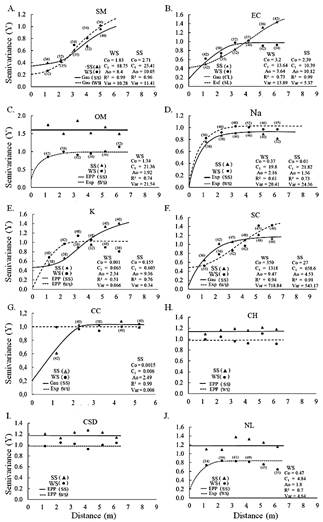
Source: The authors.
Figure 3 Experimental and theoretical semivariograms for the % soil moisture (g g-1) (A), electrical conductivity (dS m-¹) (B), organic matter available in soil (g kg-¹) (C), sodium (D) and potassium (cmol kg-¹) (E) contents, sand (F) and clay (g kg-1) contents (G), crop height (m) (H), crop stalk diameter (m) (I) and the number of leaves (J).
SM and EC were described by a Gaussian function for both treatments. There was a decrease in the scale of dependence of soil gravimetric moisture, when the sludge was applied, due to a greater uniformity in the area. For EC, Na and K content, the dependence scale increased with the sludge application. For OM, the WS treatment was described by an exponential model, while the SS treatment did not show spatial dependence.
Of the biometric parameters, only NL, in the WS condition, showed spatial dependence; the others showed a pure nugget effect pattern. The semivariograms for the variables SM, EC, Na, K, SC and CC were validated according to the Jack-Knifing criterion, with the standard deviation close to one for WS (0.986, 1.016, 0.904, 1.186, 0.987, 1.042, 1.116) and SS (1.130, 1.109, 0.999, 1.281, 1.082, 0.946, 1.035), as well as the mean errors close to zero of WS (-0.040, 0.008, 0.047, -0.038, 0.024, -0.004, -0.004) and SS (0.013, 0.014, 0.005, 0.031, 0.012, 0, -0.001).
According to the semivariograms, soil parameters under both treatment conditions did not show a sill. This is because the size of the sampling area is not enough to obtain independent values. In other words, all points are spatially correlated. Kriging mapping for soil properties and plant variables in plots SS and WS are displayed in Fig. 4.
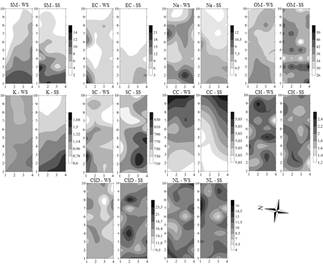
Source: The authors.
Figure 4 Isoline maps for the % soil moisture (g g-1) (SM), electrical conductivity (dS m-¹) (EC), organic matter available in soil (g kg-¹) (OM), sodium (Na) and potassium (cmol kg-¹) (K) contents, sand (SC) and clay (g kg-1) (CC) contents, crop height (m) (CH), crop stalk diameter (m) (CSD) and the number of leaves (NL).
The highest values of SM in SS and WS occurred at the bottom of the area, showing a strong relationship with the EC, with Spearman's correlation coefficient of 71%. According to [29], the spatial variability of soil EC, in addition to being attributed to the salt contents found in irrigation water, is also influenced by soil moisture. In this area, which has a high sand content, there are also high levels of organic matter, which may have influenced the high levels of salts, mainly of K, despite not reducing the CSD and NL variables. The highest Na+ concentrations occurred at the zones that had the highest EC. Similarly, K content showed spatial dynamics like that of Na content, with a higher concentration in areas with greater water availability.
4. Conclusions
1. The application of the treated domestic effluent did not cause soil salinization in the experimental plots, being useful in the maintenance of agricultural crops and important for increasing water availability in the region;
2. Sewage sludge applied on the soil acted as a cover, promoting areas with higher soil moisture and enhancing plant development;
3. The addition of treated sewage sludge decreased the soil electrical conductivity and favored the increase in organic matter content, thus contributing to a higher growth of maize managed with sludge;
4. With sludge addition, maize showed superior development in terms of crop stalk diameter, compared to the cultivation with only wastewater;
5. The present study demonstrated the high potential of treated effluent reuse for agriculture in a semi-arid region, representing an alternative source of water and nutrients for agricultural production.














